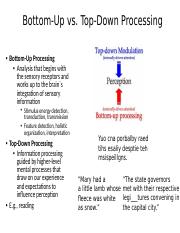

So, we are looking at this set of circles, these white circles with Seeing are a bunch of circles, they are just a bunch of circles and then inside the circle there areĪ couple of lines drawn. So, let's look at this example over here.

So, in contrast, top-down processing basically uses your background knowledge, so uses your background knowledge to influence perception. It is that you're looking at directs your cognitiveĪwareness of the object. So, bottom-up processing is data-driven, and your perception of what With no preconceived idea of what it is that you're looking at, and allow the stimulus to influence your perception of what it That is new and novel to me, and trying to kind of comprehend So, basically all the different stimuli, so this stimulus, a bunch of gauges, and this rudder-looking thing, I'm basically looking at all the different little parts of something I'm not a pilot, so I'm not really too familiar with everything and everything kinda looks fairly confusing. So, for example let's imagine that I'm looking at a cockpit of a plane. It is I'm looking at, yet I don't know anythingĪbout, I've never seen it, I don't have any preconceivedĬognitive constructs about what it is I'm looking at. Nothing about something, then the stimulus or whatever The banana is sitting there and it influences what we perceive. We're looking at something, or let's say I'm looking at a banana. So, what is bottom-up processing? Bottom-up processing basicallyīegins with the stimulus, so let's imagine that The difference between top-down and bottom-up processing.


 0 kommentar(er)
0 kommentar(er)
